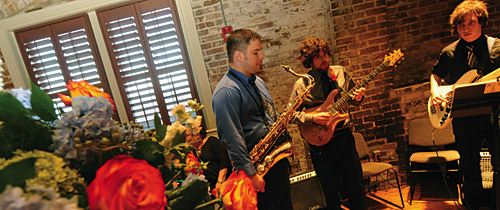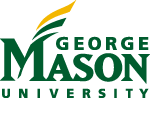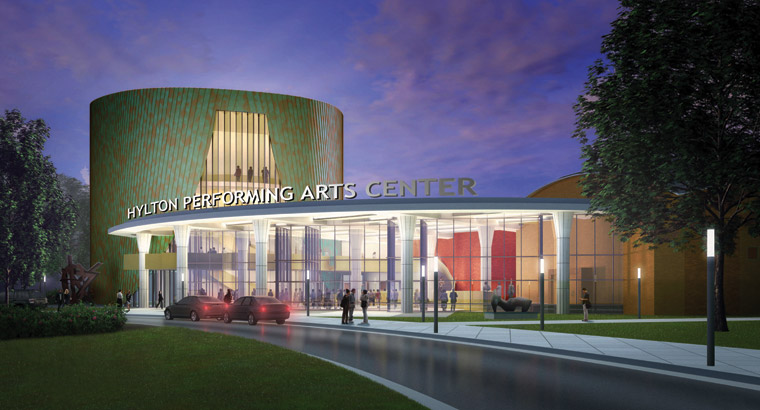
Raising the Curtain
The new Hylton Performing Arts Center on the Prince William Campus promises new possibilities for the local community and Mason students
It’s one of those boiling, sticky days in the thick of the Virginia summer where the heat hits you like a brick wall the moment you step outside. But the high temperature hasn’t hampered activity at this buzzing construction site in suburban Prince William County. From the ground, it doesn’t look like much yet—some leveled dirt, the dove-gray cement foundation, and a huge hole where the orchestra pit will be.
Now squint your eyes a bit and let the building rise before you—a stunning design of copper, glass, and brick. Not everyone has the imagination to make this apparition appear from these humble beginnings, but some visionaries had the necessary foresight. Namely, those involved with the unique partnership between George Mason University, Prince William County, and the City of Manassas that will bring this structure to life.

An artist’s rendering illustrates the opera-house style of the center’s main hall (above), made possible by a generous gift from Carol Merchant Kirby (below) and her husband, Peter.
The idea for a performing arts center, set on Mason’s Prince William Campus, was set in motion almost 20 years ago, when, in 1990, county officials conducted a visioning exercise that imagined the area in the future. The partnership concept is based on the success of the Freedom Aquatic and Fitness Center, the facility on the Prince William Campus that is open to the local community.
“Mason’s mantra for this project has been, ‘What can we do together that we can’t do alone?’” says Brian Marcus, associate dean for development and alumni affairs in the College of Visual and Performing Arts (CVPA). “Prince William County has become a vibrant, exciting community, but what it lacked was a first-class performing arts facility.”
The cost for the design and construction of the building will be split between the three partners—Mason’s contributing 30 percent, the county is responsible for 60 percent, and the city will cover 10 percent, up to $36 million total. The remainder will be supported by private gifts. The university will own and operate the 86,000-square-foot facility and also donated the land, worth about $3 million, along with the fund raising and construction management for the project.
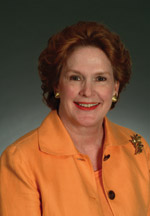 “The Hylton Center is one of the partnership projects that defines the Mason philosophy. It illustrates how we can work with communities to successfully plan and implement a project that benefits everyone,” says Mason president Alan Merten. “Serious discussions began in 1998 that focused on the need for a performing arts venue to complement the commercial, residential, and retail growth in the Prince William region. Thanks to the generous support of the Hylton Foundation and many others, the project is now under construction.”
“The Hylton Center is one of the partnership projects that defines the Mason philosophy. It illustrates how we can work with communities to successfully plan and implement a project that benefits everyone,” says Mason president Alan Merten. “Serious discussions began in 1998 that focused on the need for a performing arts venue to complement the commercial, residential, and retail growth in the Prince William region. Thanks to the generous support of the Hylton Foundation and many others, the project is now under construction.”
A Model for Other Universities
Born of such an innovative joint venture, it’s fitting that the facility’s design is just as original. Holzman Moss Architecture in New York and Hughes Group Architects in Sterling, Virginia, designed a building with a main performance hall inspired by classic European opera houses. Rather than a typical long-and-narrow auditorium, the 1,166-seat Merchant Hall will soar up nearly 10 stories with 27 elevated family boxes encircling the 527 seats on the ground level.
The 300-seat Gregory Family Theater features flexible seating that can be set up for nearly any kind of performance—dance, chamber music, or spoken word. And the Didlake Grand Foyer will function as a sort of town square of the center, explains Marcus. The 10,000-square-foot space will be able to accommodate up to 300 people for a seated dinner. Upstairs, the Buchanan Partners Gallery will display artwork from local and regional artists.
The programming plans are as ambitious as the design. Jean Kellogg, the executive director of the Hylton Center, says, “The idea is to build a facility to support all of the young talent in the area and give them a place to learn and succeed.”
Merchant Hall will draw big-name touring artists looking for a more intimate setting than other campus venues offer. From ballet to bluegrass to Broadway, Kellogg plans on bringing many different kinds of performers to the center. Because Prince William County is also home to numerous families—nearly 30 percent of its residents were under the age of 18 according to the 2006 Census estimates—there will be plenty of family programs, says Kellogg.
“The Freedom Center is such a huge success, so we already have the proof that this partnership works,” explains Kellogg. “I think this will become a model for universities across the country.”
A Community Gathering Spot
But more than the county residents will benefit from the Hylton Center. Several local arts groups—including the Prince William Symphony and Manassas Ballet Theatre—will be able to call the venue home.
“Right now, many of the local arts groups perform in middle schools or churches,” Kellogg says. “The ballet company actually performs on a cement floor in a school gym.” Kellogg also hopes to grow a regional opera company, explaining, “The design is based on an opera house, after all.”
Mason students will also reap the rewards of a first-rate performing arts center by using it as an impressive classroom.
“In addition to benefiting the residents of Prince William County and the region, the Hylton Center will have a major impact on the academic life of the College of Visual and Performing Arts,” says Bill Reeder, CVPA dean. “Our music, dance, theater, film, and arts-management students will have superb, state-of-the art facilities in which to train, work, and perform.”
The extra space will also help grow the arts programs. “Over time, we plan to have a number of classes at the Hylton Center, as well as concerts by Mason student ensembles, the GMU Dance Company, and performances by the GMU Players and Theater of the First Amendment,” Reeder says.
Even Mason-sponsored groups such as the Potomac Arts Academy, a CVPA program that offers classes to community members, are getting in on the action.
“Having the Hylton performing venue will allow us to expand all our programs into the Prince William community,” says Libby Curtis, manager of the Potomac Arts Academy. “The ability to better serve the area with high-quality arts programs is very exciting and challenging. The possibilities are endless!”
Interested in participating in the Hylton Challenge? The Take a Seat Campaign allows donors to be recognized with a plaque on a seat in Merchant Hall for a gift of $2,500 payable over five years. For more information or to make a gift of any size, contact Brian Marcus at 703-993-8607 or visit www.hyltonperformingartscenter.com.
Funding the Dream
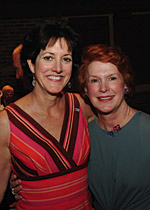
At an event thanking lead donors of the Hylton center, Executive Director Jean Kellogg poses with Carol Merchant Kirby.
Several big gifts from private donors have already been pledged, but more money is needed to establish a permanent endowment for the center. The income earned off the endowment will allow for affordable rental costs and ticket prices, ensuring it truly remains a community performing arts center. The campaign committee hopes to reach its $15 million goal by the time the facility opens in 2010.
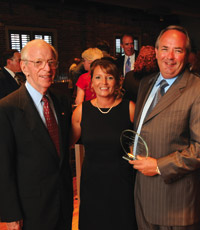
Dr. Marvin Gillum, former mayor of Manassas, presents Michele and Donnie Hylton with a recognition award
To date, about $10 million has been raised for the endowment and operating costs. The Cecil and Irene Hylton Foundation made a generous $5 million grant to the project—half of which is a challenge grant, meaning the Hylton Foundation will match every gift raised for the center, dollar for dollar, up to $2.5 million.
Carol Merchant Kirby, a Manassas native, and Peter Kirby committed $1 million to the center, and the main performance space will be named Merchant Hall in recognition of that gift. Another longtime resident of the city, John O. Gregory, gave $750,000 to name the Gregory Family Theater in memory of his wife, Angela, and son, Scott.
The Didlake Foundation, with a gift made possible from the estates of Mr. and Mrs. Roger J. Costello, will partner with the Hylton Center as well. Local companies that have made lead gifts include Lockheed Martin; Buchanan Partners; the American Type Culture Collection; Dominion; Temporary Solutions Inc.; Micron; Vulcan Materials; Vanderpool, Frostick & Nishanian; NOVEC; V2 Systems; IDI Group Companies; Thompson & Associates; BB&T; Scott & Stringfellow; and Sammis and Associates.
